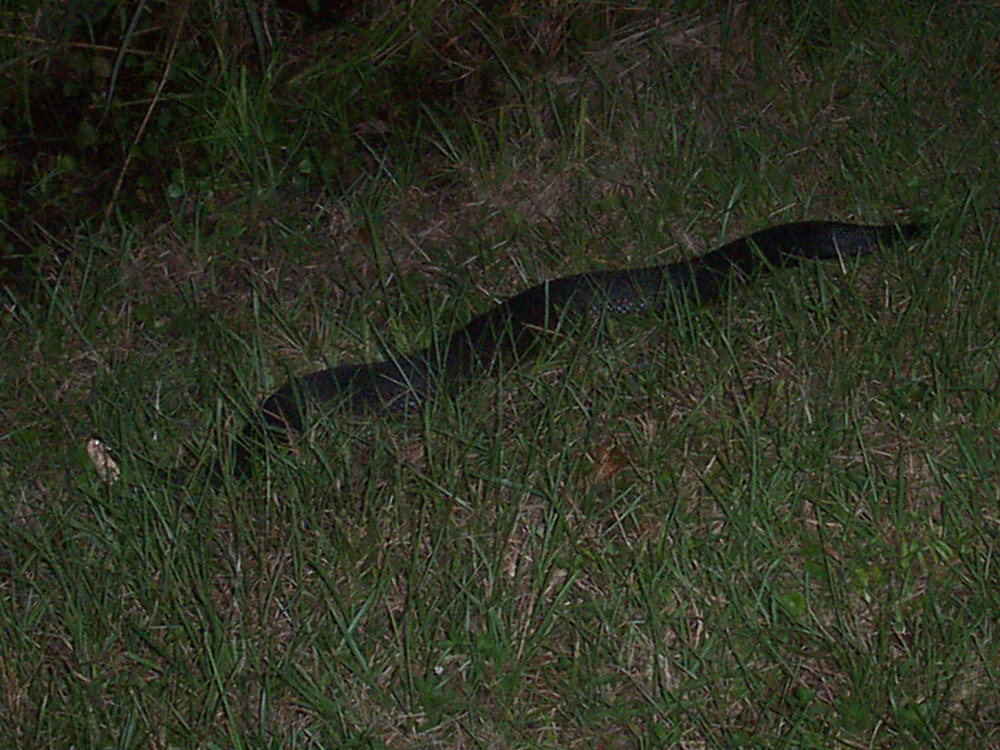|

 |
This Cottonmouth was like, fatter'n a football, seriously. |
 |
DESCRIPTION: It's hard to tell from this photograph, but this was a HUGE and amazing Cottonmouth.
If you need snake removal in your town, click for the National Directory of
Snake Removal Companies that I've carefully compiled in every USA city.
Fat cottonmouth snakes are commonly referred to as a water moccasin. This is the snake that most frequently gets confused with other snakes. Usually, any snake that is found near the water is considered a water moccasin. If you find a cottonmouth snake it is important that you do not corner it. These reptiles are extremely poisonous and have an aggressive behavior when they become threatened. Fat cottonmouths are able to deliver a bite that is really powerful.
If you are unsure if you have found a cottonmouth, you may want to observe the while lining on the inside of their mouths. When a cottonmouth becomes agitated or feels that it is threatened, it will open its mouth in a posture that is considered defensive. If you are able to observe the cottonmouth from the side, you will notice that they are usually six feet in length as well as heavy bodied. Cottonmouths differ from other snakes as they are powerful swimmers that are as comfortable in the water as they are on land.
Their eyes will also help most people determine the difference between a cottonmouth and a water snake. A cottonmouth has elongated pupils as opposed to the round pupils of most water snakes. Their heads are also flat with their eyes on the flattened sides of their heads. The water snakes have eyes on the rounded section of their skulls. Beware that throughout the years, the water snake has leaned to flatten their heads for protection.
The colorations of these reptiles will usually change throughout their lives. An adult cottonmouth will generally be darker in color ranging from tan, to brown to black. Most cottonmouth snakes are black with bands that cross their back that fade as they become older. Their tail’s tips are usually brightly colored and used as a lure to bring their prey closer to them.
Running a wildlife removal business in the state of Florida gives me the chance to see all kinds of interesting snakes! Florida has about 45 species of snake, and I've seen 29 of them so far. I've always got my eye out for new species, and
I love spotting rare snakes in Florida. I also have a thing for venomous snakes - they're not too common in FL, so I always enjoy the chance to see a poisonous serpent. I really like snakes, and I've never hurt or killed one. They're an
important part of the ecosystem, and often persecuted. Still, if you don't want snakes in your house or on your property, and judging from the number of phone calls I receive regarding snake problems, you don't, then give me or a local snake
expert in your area a call, and we can remove the snakes from your property for you. I use many snake control methods - from snake traps, to snake repellents, to habitat modification, but most of all, good old-fashioned capture and removal.
If you want to learn more, please read my How To Get Rid of Snakes page.
AAAnimal Control is a privately owned wildlife removal and pest control business, located in Orlando Florida. I deal strictly with wild animals including snakes inside houses. I am not an extermination company, but a critter removal
and control specialist. The above photos are some of the many that I've taken in the field over my years of work. Please email me if
you have any questions about the above photographs, or any questions about
wildlife problems or Florida snake removal issues.
You can safely catch snakes with a special trap, which you can order by clicking this banner:

|
| |
|